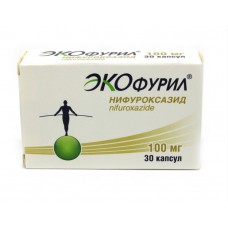Expiration date: 08/2028
Composition
1 capsule of
nifuroxazide 100 mg
Excipients: lactulose - 300 mg, microcrystalline cellulose - 23 mg, potato starch - 9 mg, magnesium stearate - 4 mg, sucrose - until the mass of the capsule contents is 460 mg.
The composition of solid gelatin capsule No. 0: gelatin - up to 100%, water - 14-15%, quinoline yellow dye - 0.5834%, sunset yellow dye - 0.0026%, titanium dioxide - 0.9740%.
1 capsule of
nifuroxazide 200 mg
Excipients: lactulose - 300 mg, microcrystalline cellulose - 58 mg, potato starch - 18 mg, magnesium stearate - 6 mg, sucrose - until the mass of the capsule contents is 630 mg.
Composition of solid gelatin capsule No. 00: gelatin - up to 100%, water - 14-15%; lid: crimson dye [Ponceau 4R] - 0.079801%, patent blue dye - 0.00165%, sunset dye - 0.093301%, titanium dioxide - 0.813158%; body: quinoline yellow dye - 0.583356%, dye sunset - 0.002565%, titanium dioxide - 0.974035%.
Dosage form
Capsules
Description
solid gelatin, No. 00, with a yellow body and an orange lid; the contents of the capsules are granulated yellow powder with white inclusions.
Action
Antimicrobial agent, a derivative of nitrofuran.
Nifuroxazide blocks the activity of dehydrogenases and inhibits respiratory chains, the tricarboxylic acid cycle and other biochemical reactions in the microbial cell. Destroys the membrane of the microbial cell, reduces the production of toxins by microorganisms.
It is highly active against: Campilobacter jejuni, Escherichia coli, Salmonella spp., Shigella spp., Clostridium perfringens, Vibrio cholerae, pathogenic Vibrions and Vibrio parahaemolyticus, Staphylococcus spp.
Weakly sensitive to nifuroxazide: Citrobacter spp., Enterobacter cloacae and Proteus indologenes.
Resistant to nifuroxazide: Klebsiella spp., Proteus mirabilis, Providencia spp., Pseudomonas spp.
Nifuroxazide does not disrupt the balance of the intestinal microflora. In case of bacterial diarrhea, it restores intestinal eubiosis. When infected with enterotropic viruses, it prevents the development of bacterial superinfection.
Pharmacokinetics
After oral administration, nifuroxazide is practically not absorbed from the digestive tract. It has an antibacterial effect exclusively in the intestinal lumen.
Nifuroxazide is excreted by the intestine: 20% is unchanged, the rest is chemically modified.
Indications for use
- acute bacterial diarrhea, occurring without deterioration of the general condition, increase in body temperature, intoxication.
Contraindications
- hypersensitivity to nifuroxazide, other nitrofuran derivatives or any excipients of the drug;
- children under 3 years of age;
- pregnancy;
- fructose intolerance, glucose-galactose malabsorption syndrome or sucrose/ isomaltase deficiency (due to the presence of sucrose in the preparation).
With caution, the drug should be prescribed for liver diseases, alcoholism, traumatic brain injury, brain diseases, during lactation, and children's patients.
Use during pregnancy and lactation
No teratogenic effect has been found in animal studies. However, as a precautionary measure, taking nifuroxazide during pregnancy is not recommended.
During lactation, it is possible to continue breastfeeding in the case of a short course of treatment with the drug. It is necessary to consult with a doctor.
Use in children
The use of the drug in children under 3 years of age is contraindicated.
The drug should be prescribed with caution to children's patients.
Side effects
Allergic reactions: skin rash, urticaria, Quincke's edema, anaphylactic shock.
If any of the side effects indicated in the instructions are aggravated or any other side effects not indicated in the instructions are noted, the patient should inform the doctor about this.
Interaction
Simultaneous use with drugs that cause the development of disulfiram-like reactions, as well as with drugs that inhibit the function of the central nervous system, is not recommended.
If the patient is taking other medications (including over-the-counter ones), consult a doctor before using Ecofuril®.
Method of administration and dosage
The drug is taken orally.
Adults are prescribed 200 mg (2 capsules of 100 mg or 1 capsule of 200 mg) 4 times / day (interval between doses of 6 hours).
Children aged 3 to 6 years - 200 mg (2 capsules of 100 mg or 1 capsule of 200 mg) 3 times / day (the interval between doses is 8 hours); children aged 6 to 18 years - 200 mg (2 capsules of 100 mg or 1 caps. 200 mg) 3-4 times / day (the interval between doses is 6-8 hours).
The duration of the course of treatment is 5-7 days, but not more than 7 days. If there is no improvement during the first 3 days, the patient should consult a doctor.
The drug should be used only according to the method of application and in the doses specified in the instructions.
If necessary, the patient should consult with a doctor before using the drug.
Overdose
The symptoms of overdose are unknown.
Treatment: symptomatic therapy.
Special instructions
In the treatment of diarrhea, rehydration therapy should be performed simultaneously with nifuroxazide therapy.
In the case of bacterial diarrhea with signs of systemic damage (deterioration of the general condition, fever, symptoms of intoxication or infection), the patient should consult a doctor to resolve the issue of the use of systemic antibacterial drugs.
If symptoms of hypersensitivity appear (shortness of breath, swelling of the face, lips, tongue, skin rash, itching), you should immediately stop taking the drug.
Alcohol is not allowed during nifuroxazide therapy.
The composition of the drug contains sucrose: in capsules of 100 mg - 24 mg, in capsules of 200 mg - 48 mg. Thus, a single dose of sucrose when taking capsules of 100 mg and 200 mg will be 24 mg and 48 mg, respectively. The daily dose of sucrose when taking capsules of 100 mg and 200 mg will be 96 mg and 192 mg, respectively.
Influence on the ability to drive vehicles and manage mechanisms
The drug does not affect the ability to drive vehicles and mechanisms.
Conditions of release from pharmacies
without a prescription.
Storage conditions
The drug should be stored in a place protected from moisture and light, inaccessible to children at a temperature not exceeding 25 ° C.
The shelf life is 5 years. Do not use after the expiration date.


